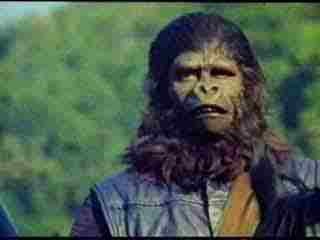
March 20, 2006
The Malaysian newspaper, The New Strait Times has done a relatively good job of reporting on the "Malaysian Bigfoot" story, avoiding the sandtraps that exist in the usual media coverage you often read on such events.
There has been little use of the "ridicule curtain," that invisible barrier of demeaning coverage that often develops by elitist writers who wish to demonstrate the "masses" don’t know what they are talking about.
But that all changed with Rehman Rashid’s Opinion column on March 20th, "They seek him here, they seek him there…" that you will find in today’s New Strait Times.
Rashid informs us, in part:
The Bigfoot phenomenon reflects a part of the defining human capacity for curiosity and wonder, without which we’d be apes.
The trouble with Bigfoot is that he’s giving cryptozoology a bad name.
It’s ridiculous to presume that every life-form on Earth has been discovered, more so even than to imagine we might be the only form of intelligent life in the Universe. This is the worst kind of arrogance, borne on what we do not know.
But our ignorance of a creature’s existence has no bearing on whether or not it exists, and speculating on unknown fauna — "cryptozoology" — is part of the defining human capacity for curiosity and wonder, without which we’d be apes.
Okay, that’s a good start. This is a well-reasoned opening that Rashid carries forth with examples of the coelacanth and the megamouth, and lost worlds in Laos, populated with two new species of muntjacs, and a Sumatran stream holding a new species of fish.
But he should have stopped while he was ahead. Speaking of the new Sumatran fish discovery as his jumping off point, Rashid proclaims:
That special little event in natural history, however, was hereabouts drowned in the hullabaloo over the Johor Bigfoot, which had reached fever pitch since the reported sighting last November of a huge, hairy, bipedal beast in Kota Tinggi district.
…The size-50 footprints, broken branches and matted vegetation in Johor have so far added no more than a few scrawled lines to the turgid reams of pseudo-science and outright chicanery spawned by this enduring, worldwide and absolutely silly "Bigfoot phenomenon".
Rashid then begins to make several factual errors in his rush to skepticism in this column.
But no one has yet snapped a decent photo of one, or even found anything that could pass for a Bigfoot’s droppings, fur, artefacts, skeletal remains, or any other evidence of the presence anywhere of a three-metre-tall man-ape, anytime between 100,000 years ago and last night.
Oh yes, there was that infamous 16mm home movie by Roger Patterson and Robert Gimlin, shot in northwest California in 1967 and featuring a few seconds’ footage of a O Roger loping off into the middle distance, even casting a nonchalant glance back at the camera.
The debate over whether that creature’s bouncy chest meant it was female was enough to divert attention from the fact that Patterson and Gimlin had made that film at the same time as Charlton Heston & Co were filming Planet of the Apes on location nearby.

The Patterson-Gimlin Bigfoot was a man in a monkey suit, as surely as the Loch Ness Monster in its best-known photograph was a plasticine model stuck on a toy submarine.
I won’t get too distracted by listing all the physical evidence for Bigfoot that has been found or answering Rashid’s incorrect Loch Ness references here, of a model that was a fantasy in a time when that type of "plasticine" did not exist, or how the second Nessie photograph in 1934 was ignored by the skeptics. No, let’s stick with Rashid’s incredible Bigfoot "movie links" hypothesis, for a minute.
Rashid writes:
Movie tie-ins are not unknown in these matters. The re-make of King Kong was showing in local cineplexes when the Johor Bigfoot made its appearance late last year, again suggesting the power of suggestion. But appear it reportedly did, to Orang Asli, jungle-fringe villagers and weekend hikers with a common propensity to believe in the paranormal, supernatural, or plainly implausible.
Let’s stop there, and answer some of his factual errors so quickly tossed our way.
First, as Rashid notes earlier, the first reports of the "Malaysian Bigfoot" or Orang Dalam or Mawas, issued from a sighting in November 2005, not of "a" single "huge, hairy, bipedal beast," as he indicates, but of two large three meter (10 feet) tall hirsute hominoids and another, smaller human-sized one. That’s his first mistake.
Rashid feels the King Kong movie was responsible for these sightings. But King Kong had a release date, around the world, including in Malaysia, of December 14, 2005. The initial sighting in November seems hardly stimulated by what Rashid calls the "Orang Asli, jungle-fringe villagers" and any copycat Kong sightings. However, the media interest in running with the story and giving it importance may have been due to the giant gorilla movie. The "Malaysian Bigfoot" cause and effect is only about its media coverage, not the reason these folks saw those creatures in the first place.
Another part of Rashid’s "movie tie-in" theories with Bigfoot is the old chestnut about the Patterson-Gimlin footage having something to do with the 1967 shooting of Planet of the Apes. This is a shadow of the talk that circulated for years that makeup artist John Chambers (who won the first Oscar for makeup due to the 1968 movie’s "ape" costumes) made the Patterson-Gimlin Bigfoot’s "suit." Chambers’ denial is forgotten, and this Malaysian editorial writer appears to be repeating a bad memory of this old overturned argument.
What Rashid and others ignored for years is that the suits Chambers won so much praise for only showed the apes’ hairy bodies with a hairy head here, a hairy hand there, as the entire rest of the actors were covered with body armor and robes. Look at the photographs from that movie. There is nothing appearing in Planet of the Apes even marginally looking like the Patterson Bigfoot.

As to Rashid’s statement that the location for that film was nearby, that’s just ridiculous. As noted in the Planet of the Apes (Widescreen 35th Anniversary Edition), released in 2004, the motion picture’s exteriors were filmed in Utah and Arizona national parks. The specific filming locations are listed as: 20th Century Fox Ranch, Malibu Creek State Park – 1925 Las Virgenes Road, Calabasas, California, USA; Cabo San Lucas, Baja California Sur, Mexico; Glen Canyon, Utah, USA; Lake Powell, Utah, USA; Malibu, California, USA; Page, Arizona, USA;| University of California, Irvine, California, USA; and Zuma Beach, Malibu, California, USA. Not one of these locations are anywhere near Bluff Creek, California.
Rashid ends the editorial with this comment, discussing the Malaysian sightings of Bigfoot:
This doesn’t stop them seeing what they want to see, alas, and what the gul
lible are prepared to believe they see could make a monkey of anyone.
I’d have to say that this Malaysian writer just did a rather good job of making a monkey out of himself with critiques leveled without foundation and based on incorrect facts.
About Loren Coleman
Loren Coleman is one of the world’s leading cryptozoologists, some say “the” leading living cryptozoologist. Certainly, he is acknowledged as the current living American researcher and writer who has most popularized cryptozoology in the late 20th and early 21st centuries.
Starting his fieldwork and investigations in 1960, after traveling and trekking extensively in pursuit of cryptozoological mysteries, Coleman began writing to share his experiences in 1969. An honorary member of Ivan T. Sanderson’s Society for the Investigation of the Unexplained in the 1970s, Coleman has been bestowed with similar honorary memberships of the North Idaho College Cryptozoology Club in 1983, and in subsequent years, that of the British Columbia Scientific Cryptozoology Club, CryptoSafari International, and other international organizations. He was also a Life Member and Benefactor of the International Society of Cryptozoology (now-defunct).
Loren Coleman’s daily blog, as a member of the Cryptomundo Team, served as an ongoing avenue of communication for the ever-growing body of cryptozoo news from 2005 through 2013. He returned as an infrequent contributor beginning Halloween week of 2015.
Coleman is the founder in 2003, and current director of the International Cryptozoology Museum in Portland, Maine.
Filed under Bigfoot, Cryptotourism, CryptoZoo News, Cryptozoologists, Cryptozoology, Eyewitness Accounts, Forensic Science, Malaysian Bigfoot, Media Appearances, Movie Monsters, Obituaries, Out of Place, Pop Culture, Public Forum, Sasquatch